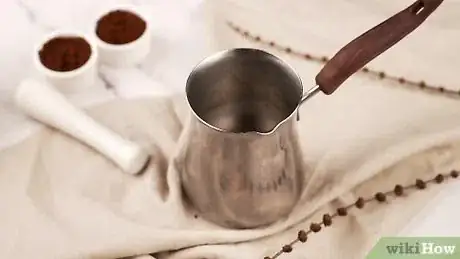This article was co-authored by wikiHow Staff. Our trained team of editors and researchers validate articles for accuracy and comprehensiveness. wikiHow's Content Management Team carefully monitors the work from our editorial staff to ensure that each article is backed by trusted research and meets our high quality standards.
The wikiHow Culinary Team also followed the article's instructions and verified that they work.
This article has been viewed 156,671 times.
Learn more...
Greek coffee (also called Ellinikós kafes) is similar to Turkish coffee, in that they're both made on a stovetop using unfiltered coffee grounds. This type of coffee might also be called Arabic, Cypriot, Armenian, or Bosnian coffee, but there are slight differences in the method depending on the country. Greek coffee is thick, foamy, and made with coffee beans that have been ground to a fine powder. Unlike American coffee, Greek coffee is meant to be sipped and enjoyed over many hours.
Ingredients
Makes one cup
- 2 ounces (59 ml) water
- 1 heaping teaspoon (2 g) Greek coffee
- ½ to 2 teaspoons (2.5 to 10 g) sugar, to taste
Steps
Choosing the Right Equipment
-
1Use Greek coffee beans. Greek coffee is different from other coffee in many ways, and it all starts with the beans. For Greek coffee, Arabica beans are lightly roasted and ground to a fine powder. The type of bean, the roast, and the grind all contribute to the unique flavor of Greek coffee.
-
2Make the coffee in a briki. A briki is a special metal coffee pot that’s used specifically to make Greek coffee in the traditional way. It’s usually an hourglass- or cauldron-shaped metal pot with a long handle. Greek coffee is made right in the briki, which is warmed over a gas stove.
- You can heat a briki on an electric range as well, though Greek coffee is traditionally made on a gas stove or over an open flame.
- If you want to make traditional Greek coffee but don’t have a gas stove, you can use a small single-burner camp stove as well.
- A briki comes in many different sizes, and you should use the correct size for the amount of coffee you're making.
Advertisement -
3Serve the coffee in a demitasse. A demitasse is a small cup used for serving small amounts of coffee or espresso. Each one holds between 2 and 3 ounces (59 and 89 ml). Greek coffee is traditionally served in a demitasse cup with an accompanying saucer.
- These small cups can be found in many kitchen stores, but you can also use espresso cups if you don’t have demitasse cups.
Brewing the Coffee
-
1Measure the water. The traditional way to measure water for Greek coffee is by using a demitasse cup to measure. Fill the demitasse with water, and then pour that water into the briki.[3]
- By using the same cup you'll be serving coffee in, measuring with the demitasse ensures that you make exactly the right amount of coffee.
-
2Add the coffee and sugar. For each cup of coffee you're making, measure in one heaping teaspoon of Greek coffee grounds. Unlike Turkish coffee, you don’t add spices like cardamom to Greek coffee, but you can add sugar if you like. Depending on the level of sweetness you want, add:
- No sugar for plain, or sketos
- ½ teaspoon (2.5 g) sugar for half-sweet, or meoligi
- 1 teaspoon (5 g) of sugar for medium, or metrios
- 2 teaspoons (10 g) of sugar for sweet, or glykys
-
3Mix and heat the coffee. Swirl the coffee, sugar, and water together to combine all the ingredients in the briki. Turn the gas to medium and transfer the briki to the heat.[4]
- As the coffee heats up, it will begin to bubble and foam as it simmers. Do not stir, swirl, or otherwise disturb the coffee at this point, or you will destroy the foam, which is an integral part of Greek coffee.
- Don’t let the coffee boil over either, or you'll lose the foam.
- When the coffee nears the rim of the briki, remove it from the heat.
-
4Serve in the demitasse. When you take the coffee off the flame, pour it immediately into the demitasse, along with the foam and grounds. Be gentle so you don’t disturb the foam.
- If you're making more than one coffee, make sure you distribute the foam evenly among all the cups. Use a spoon to transfer foam from one cup to another if necessary.[5]
Drinking Greek Coffee
-
1Drink the coffee in the morning or after a nap. In Greece, Greek coffee is typically consumed when you get up in the morning, and then again when you wake from an afternoon nap.[6]
- In most Greek cities, islands, and towns, the hours of 2 to 5 p.m. are considered quiet time, and many people nap during these hours. After the nap, coffee is served again.
-
2Serve with ice water. Greek coffee is almost always served with a glass of cold water or ice water. And while it’s not necessary, the coffee is often served with a cookie or some other type of sweet as well.[7]
-
3Let the grounds settle before drinking. Because Greek coffee is unfiltered and served with the grounds, it’s best to let the coffee settle for a minute or two after it’s poured. This gives the grounds time to settle on the bottom, so you can enjoy the coffee.[8]
-
4Drink slowly. Greek coffee is meant to be sipped and enjoyed leisurely over the course of a couple hours. To get the most flavor from the coffee, take small, slow sips so the coffee has time to roll around in your mouth.[9]
- Espresso, on the other hand, is consumed quickly while standing up, whereas the coffee is sipped slowly while sitting down and chatting with friends, family, or neighbors.
-
5Don’t drink the powdery grounds at the bottom. When you get near the end of the coffee, you will run into the powdery coffee grounds that settled on the bottom. When you get to that point, your coffee is finished, as you aren't meant to drink the grounds.[10]
Community Q&A
-
QuestionWhy isn't my Greek coffee strong in flavor?
 MicheleTop AnswererBecause most Greek beans are light roasted, therefore lighter in flavor. However, the longer it sits, the stronger it should get, so give it a bit more time.
MicheleTop AnswererBecause most Greek beans are light roasted, therefore lighter in flavor. However, the longer it sits, the stronger it should get, so give it a bit more time. -
QuestionWhere in Pretoria can I buy Greek coffee?
 Community AnswerMaybe just try ordering it anywhere. You can also go to eBay or Amazon and look up Greek coffee to make it yourself.
Community AnswerMaybe just try ordering it anywhere. You can also go to eBay or Amazon and look up Greek coffee to make it yourself. -
QuestionWhy Turkish coffee is better than Greek coffee?
 Community AnswerNeither is inherently better than the other. If you like the taste of Turkish coffee better and want to know why, it's probably that Turkish coffee is brewed with the addition of powdered cardamom.
Community AnswerNeither is inherently better than the other. If you like the taste of Turkish coffee better and want to know why, it's probably that Turkish coffee is brewed with the addition of powdered cardamom.
References
- ↑ http://www.olivetomato.com/how-to-make-and-drink-greek-coffee/
- ↑ http://www.kalofagas.ca/2011/12/06/greek-coffee-%CE%B5%CE%BB%CE%BB%CE%B7%CE%BD%CE%B9%CE%BA%CF%8C%CF%82-%CE%BA%CE%B1%CF%86%CE%AD%CF%82/
- ↑ http://www.olivetomato.com/how-to-make-and-drink-greek-coffee/
- ↑ http://www.kalofagas.ca/2011/12/06/greek-coffee-%CE%B5%CE%BB%CE%BB%CE%B7%CE%BD%CE%B9%CE%BA%CF%8C%CF%82-%CE%BA%CE%B1%CF%86%CE%AD%CF%82/
- ↑ http://www.chowhound.com/recipes/greek-coffee-ellinikos-kafes-28232
- ↑ http://www.olivetomato.com/how-to-make-and-drink-greek-coffee/
- ↑ http://www.kalofagas.ca/2011/12/06/greek-coffee-%CE%B5%CE%BB%CE%BB%CE%B7%CE%BD%CE%B9%CE%BA%CF%8C%CF%82-%CE%BA%CE%B1%CF%86%CE%AD%CF%82/
- ↑ http://www.kalofagas.ca/2011/12/06/greek-coffee-%CE%B5%CE%BB%CE%BB%CE%B7%CE%BD%CE%B9%CE%BA%CF%8C%CF%82-%CE%BA%CE%B1%CF%86%CE%AD%CF%82/
- ↑ http://www.olivetomato.com/how-to-make-and-drink-greek-coffee/
About This Article
If you want to make Greek coffee, start by putting 1 demitasse of water into the briki for each cup you want to make. Then, add 1 heaped teaspoon of ground Greek coffee per cup of coffee. Add sugar if you want the coffee to be sweet. Mix the coffee grounds and water together. Then, heat the briki on the stove over medium heat. When the coffee nears the rim of the briki, remove it from the heat. Immediately pour the coffee into the demitasse, taking care not to disrupt the foam, and serve.































































